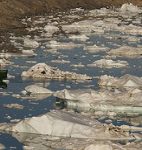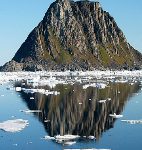Crusted with snow and ice, they stand like monuments to a lost era. With their windows gaping empty over the freezing tundra, the deserted apartment blocks of Yor Shor speak of a time when the Kremlin believed ideology and industry could defeat nature.
A decade ago, more than 5,000 people lived in this village about 110 kilometres beyond the Arctic Circle in Russia’s far north, where winter temperatures drop to -50° Celsius and blizzards sweep down from the North Pole, burying cars and whisking roofs from houses. The population today? Ten.
“We are the last survivors,” said Karp Belgayev, 52, a miner, whose family is one of two in a pitted five-storey apartment block. “The shop, the school, the restaurant, the doctor’s office – they’ve all closed.” Soon the Belgayevs and their neighbours will be gone; the authorities will turn off the switch on the electricity supply and close the heating sub-station that keeps them from dying of cold. Then the human grasp on Yor Shor will unclench forever, leaving it to slowly tumble into the Arctic desert.
The demise of Yor Shor is powerfully symbolic. In the last two years, a resurgent Russia stimulated a global dash for the riches of the far north. Famously, two mini-submarines were sent to the Arctic seabed in 2007, planting a titanium Russian tricolour and claiming its millions of tonnes of hydrocarbons. In September 2008, president Dmitry Medvedev said the Arctic was a “strategic” zone that “must be transformed into Russia’s resource base for the 21st century”, and in January 2009 a government strategy document warned of a coming battle for those resources that could even escalate to warfare with competing states.
Yet there is a paradox. Just as bureaucrats in Moscow target huge resources to develop offshore Arctic gas fields and build new oil pipelines, the north is dying. Every year, thousands of people are fleeing to warmer climes. Whole settlements are abandoned. Put together, Murmansk, Norilsk and Vorkuta, the three biggest Arctic cities in the world — all in Russia — have lost almost a third of inhabitants since 1989.
Until recently, the outward migration had appeared to be slowing. But in places such as Vorkuta, a coal mining town and former gulag outpost a few kilometres from Yor Shor, there are fears of a fresh exodus as the financial downturn sends commodities prices tumbling.
Vorkuta’s coal mines belong to billionaire Alexei Mordashov, whose Severstal company is Russia’s largest steelmaker. The mines provide fuel for his steel plant — where output halved in the last quarter of 2008. That forced Vorkutaugol (Vorkuta Coal) to reduce pay packets and lay off workers. “So far only 300 people will go from a workforce of 13,000,” said Dmitry Poyarkov, a spokesman. But the recession could yet bite deeper, he admitted.
Life isn’t easy in Vorkuta. In January and February, a low sun smudges the sky for only a few hours, and in summer, clouds of mosquitoes, each insect as big as a thumbnail, hover over the marshes.
Coal was discovered here in the 1920s, and by 1934 streams of prisoners from all over the Soviet Union (USSR) were being dispatched north to serve its complex of factories. Inmates lived in wooden barracks or bunkers carved by hand from the rock-hard ground.
After the Soviet leader Josef Stalin’s death in 1953, survivors were released, to be replaced by workers from warmer regions drawn by the promise of high pay and early pensions. In places almost unfit for human habitation, the Soviets erected whole cities on permafrost, building swimming pools, cinemas and puppet theatres to entertain their polar vanguard.
But when the Soviet Union fell in 1991, the centrally planned system of subsidies and salary top-ups that supported the north collapsed. Today, many inhabitants of Vorkuta feel galled when they hear Moscow politicians trumpeting about funding the north. “Companies are obliged to pay supplements on salaries, but they just reduce the part they pay themselves so we don’t get any more than people in central Russia,” said Marina Ivanova, 46, a television reporter whose husband is a miner.
Far from being supported for living in this outpost, locals have to pay more for goods that are hauled in on the 40-hour train from Moscow in the absence of a road link. Residents who sell up and head for central Russia often leave with almost empty pockets: ballooning supply has pushed prices down so far that apartments go for as little as the equivalent of US$2,800.
Pensioners and long-term residents of the far north should get a government voucher to help buy a new home, but tens of thousands stay on waiting lists indefinitely. Still, the migration continues and Vorkuta is dotted with boarded-up housing blocks that were once full of families. “The town is dying before our eyes,” said Yaroslavl Kotov, an engineer at a nearby coal mine.
Bureaucrats in Moscow have little sympathy. Soviet planners artificially overpopulated the north because labour was cheap, the thinking goes, so today’s exodus is a readjustment to market conditions. Across the Arctic, drillers and oilmen on rotating duty tours will replace townspeople, reducing the need to support an expensive infrastructure.
Yet a legal proposal to classify the north into zones of “absolute” and “extreme discomfort” — which would help target greater social support to inhabitants of the polar region — has languished for years in the State Duma, Russia’s lower house of parliament.
For many in Vorkuta, the prospect of their town withering away is a tragedy. “I want a better future for my son and it’s no longer an advantage to live here,” said Ivanova. “But I don’t want to go. I was born here. In Moscow there’s all that slush. Here our winters are cold and hard and beautiful.”
As it is, there is a risk Vorkuta will become an economic ghetto for those who cannot afford to leave. In Yor Shor, Karp Belgayev and his family have stayed on by force of circumstance rather than choice. The permanent black rings of coal dust around the miner’s eyes tell of decades of work underground.
When the village’s colliery closed in 1998, many families moved away. Belgayev lost his job and now travels to work in another pit. He believes that under federal law his family should receive an apartment in central Russia.
But the local authorities say that Yor Shor has not officially been “liquidated” and are only offering a home in a neighbouring village, itself strewn with tumbledown buildings. Soon government bailiffs will come to evict the family.
After 30 years at the coal face, Belgayev feels cheated. “Other people drank and messed around and still got apartments in the south,” he said. “I worked half my life in a mine and got nothing. It’s not right.”
Feeling the pinch
When there is a purga, or blizzard, temperatures in the Russian far north can drop to -90°C in winter (if the wind chill factor is added).
Steel tools have been known to shatter in such extreme cold and exposed flesh freezes in a less than a minute.
Locals wear Arctic spetsodezhda (specially designed parkas and padded trousers) or reindeer skins to combat the icy climate.
The freeze, followed by the thaw in the spring, often ruptures asphalt roads and pavements. Global warming brings mixed blessings for Russia’s Arctic, opening up new sea routes and reducing residents’ heating bills, but also posing danger for cities built on permafrost, where foundations under buildings can subside as the permafrost melts.
Because moisture cannot drain through the permafrost, the Arctic tundra is covered in pools of water in the brief summer, offering the perfect habitat for mosquitoes and other biting insects.
www.guardian.co.uk
Copyright Guardian News and Media Limited, 2009
Homepage photo by Воркута


